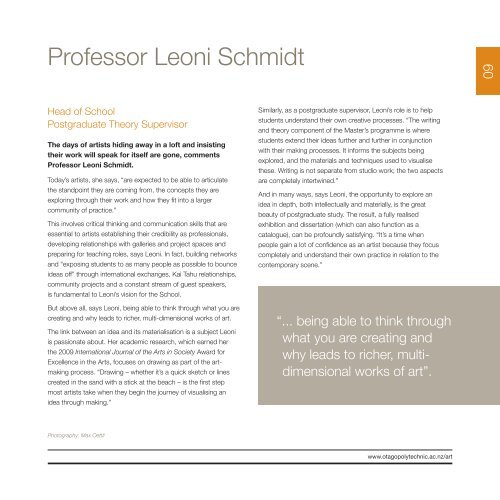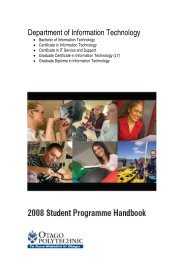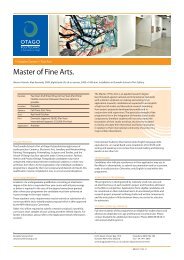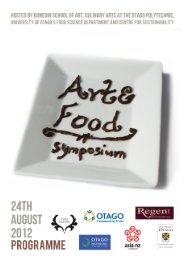Dunedin School of Art Postgrad Booklet.indd - Otago Polytechnic
Dunedin School of Art Postgrad Booklet.indd - Otago Polytechnic
Dunedin School of Art Postgrad Booklet.indd - Otago Polytechnic
Create successful ePaper yourself
Turn your PDF publications into a flip-book with our unique Google optimized e-Paper software.
Pr<strong>of</strong>essor Leoni Schmidt<br />
Head <strong>of</strong> <strong>School</strong><br />
<strong>Postgrad</strong>uate Theory Supervisor<br />
The days <strong>of</strong> artists hiding away in a l<strong>of</strong>t and insisting<br />
their work will speak for itself are gone, comments<br />
Pr<strong>of</strong>essor Leoni Schmidt.<br />
Today’s artists, she says, “are expected to be able to articulate<br />
the standpoint they are coming from, the concepts they are<br />
exploring through their work and how they fi t into a larger<br />
community <strong>of</strong> practice.”<br />
This involves critical thinking and communication skills that are<br />
essential to artists establishing their credibility as pr<strong>of</strong>essionals,<br />
developing relationships with galleries and project spaces and<br />
preparing for teaching roles, says Leoni. In fact, building networks<br />
and “exposing students to as many people as possible to bounce<br />
ideas <strong>of</strong>f” through international exchanges, Kai Tahu relationships,<br />
community projects and a constant stream <strong>of</strong> guest speakers,<br />
is fundamental to Leoni’s vision for the <strong>School</strong>.<br />
But above all, says Leoni, being able to think through what you are<br />
creating and why leads to richer, multi-dimensional works <strong>of</strong> art.<br />
The link between an idea and its materialisation is a subject Leoni<br />
is passionate about. Her academic research, which earned her<br />
the 2009 International Journal <strong>of</strong> the <strong>Art</strong>s in Society Award for<br />
Excellence in the <strong>Art</strong>s, focuses on drawing as part <strong>of</strong> the artmaking<br />
process. “Drawing – whether it’s a quick sketch or lines<br />
created in the sand with a stick at the beach – is the fi rst step<br />
most artists take when they begin the journey <strong>of</strong> visualising an<br />
idea through making.”<br />
Photography: Max Oettli<br />
Similarly, as a postgraduate supervisor, Leoni’s role is to help<br />
students understand their own creative processes. “The writing<br />
and theory component <strong>of</strong> the Master’s programme is where<br />
students extend their ideas further and further in conjunction<br />
with their making processes. It informs the subjects being<br />
explored, and the materials and techniques used to visualise<br />
these. Writing is not separate from studio work; the two aspects<br />
are completely intertwined.”<br />
And in many ways, says Leoni, the opportunity to explore an<br />
idea in depth, both intellectually and materially, is the great<br />
beauty <strong>of</strong> postgraduate study. The result, a fully realised<br />
exhibition and dissertation (which can also function as a<br />
catalogue), can be pr<strong>of</strong>oundly satisfying. “It’s a time when<br />
people gain a lot <strong>of</strong> confi dence as an artist because they focus<br />
completely and understand their own practice in relation to the<br />
contemporary scene.”<br />
“... being able to think through<br />
what you are creating and<br />
why leads to richer, multidimensional<br />
works <strong>of</strong> art”.<br />
www.otagopolytechnic.ac.nz/art<br />
09








